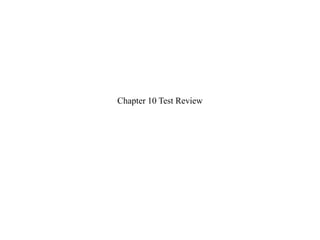Chapter 10 Test Review
•Download as PPTX, PDF•
0 likes•526 views
ch 10 test review
Report
Share
Report
Share

Recommended
Recommended
Lect. 3 gibbs helmholtz equation, chemical potential, gibbs duhem equation

Lect. 3 gibbs helmholtz equation, chemical potential, gibbs duhem equationShri Shivaji Science College Amravati
More Related Content
What's hot
Lect. 3 gibbs helmholtz equation, chemical potential, gibbs duhem equation

Lect. 3 gibbs helmholtz equation, chemical potential, gibbs duhem equationShri Shivaji Science College Amravati
What's hot (20)
Chem 2 - Chemical Equilibrium VI: Heterogeneous Equilibria

Chem 2 - Chemical Equilibrium VI: Heterogeneous Equilibria
Chem 2 - Gibbs Free Energy and Spontaneous Reactions VI

Chem 2 - Gibbs Free Energy and Spontaneous Reactions VI
2nd Lecture on Chemical Equilibrium | Chemistry Part II | 11th Std

2nd Lecture on Chemical Equilibrium | Chemistry Part II | 11th Std
Lect. 3 gibbs helmholtz equation, chemical potential, gibbs duhem equation

Lect. 3 gibbs helmholtz equation, chemical potential, gibbs duhem equation
Chem 2 - Chemical Kinetics V: The Second-Order Integrated Rate Law

Chem 2 - Chemical Kinetics V: The Second-Order Integrated Rate Law
Similar to Chapter 10 Test Review
Similar to Chapter 10 Test Review (20)
Arizona State University 1 School of Molecular Sciences .docx

Arizona State University 1 School of Molecular Sciences .docx
Application of microcalorimeter in stability study

Application of microcalorimeter in stability study
306996 u14 principles_and_applications_of_thermodynamics

306996 u14 principles_and_applications_of_thermodynamics
More from Ted Banner
More from Ted Banner (8)
Recently uploaded
Model Call Girl in Bikash Puri Delhi reach out to us at 🔝9953056974🔝

Model Call Girl in Bikash Puri Delhi reach out to us at 🔝9953056974🔝9953056974 Low Rate Call Girls In Saket, Delhi NCR
Recently uploaded (20)
Hybridoma Technology ( Production , Purification , and Application ) 

Hybridoma Technology ( Production , Purification , and Application )
Measures of Central Tendency: Mean, Median and Mode

Measures of Central Tendency: Mean, Median and Mode
18-04-UA_REPORT_MEDIALITERAСY_INDEX-DM_23-1-final-eng.pdf

18-04-UA_REPORT_MEDIALITERAСY_INDEX-DM_23-1-final-eng.pdf
Model Call Girl in Bikash Puri Delhi reach out to us at 🔝9953056974🔝

Model Call Girl in Bikash Puri Delhi reach out to us at 🔝9953056974🔝
Science 7 - LAND and SEA BREEZE and its Characteristics

Science 7 - LAND and SEA BREEZE and its Characteristics
Micromeritics - Fundamental and Derived Properties of Powders

Micromeritics - Fundamental and Derived Properties of Powders
Call Girls in Dwarka Mor Delhi Contact Us 9654467111

Call Girls in Dwarka Mor Delhi Contact Us 9654467111
Chapter 10 Test Review
- 1. Chapter 10 Test Review
- 2. Chapter 10 Test Review Bring a calculator and writing utensil to class. You must be able to operate the calculator that you bring for the test. A periodic table will be provided.
- 3. Chapter 10 Test Review Many of the types of questions will be similar to the examples given in-class, in notes and handouts, and on homework assignments. The chapter 10 test will have all types of questions: multiple choice fill in the blank definition of terms short answer calculations (temperature conversions; q = mCp∆T; ∆H)
- 4. Chapter 10 Test Review Terms that you should be able to define include: energy, kinetic energy, potential energy, law of conservation of energy, exothermic process, endothermic process, temperature, heat, convection, conduction, and radiation.
- 5. Chapter 10 Test Review You must be able to convert temperatures from one scale to another. The following mathematical formulas will be given: K = ˚C + 273 ˚F = 9/5˚C + 32 ˚C = 5/9(˚F – 32) You must be able to use algebra to manipulate any of the above equations to solve for unknown temperatures.
- 6. Chapter 10 Test Review The first set of calculations include heat transfer events and the equation q = m Cp ∆T. This equation will be given. You must know what each variable represents and what units quantities must be in when substituting into this equation. You must know ∆T = Tf – Ti. A table of specific heat values / Cp will be provided. You must be able to calculate unknown amounts of heat energy gained / lost in units of joules or kilojoules, values of specific heat, temperature change, or mass. You must know that 1 kJ = 1000 J.
- 7. Chapter 10 Test Review The second set of calculations include calculations that relate to heats of reaction and enthalpy - ∆H. You must be able to identify if a reaction is endothermic / exothermic from given values of ∆H. You must be able to calculate the amount of heat energy, in kilojoules, absorbed / released in a chemical change starting from moles of reactant/product and grams of reactant/product. You must know 1 kJ = 1000 J.